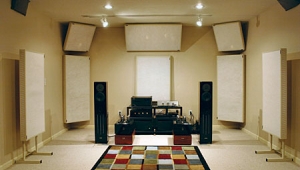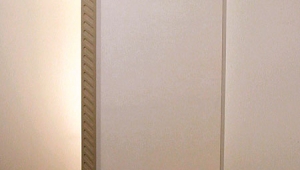| Columns Retired Columns & Blogs |
Rives Audio PARC 3-Band Parametric Equalizer
Last January, the Stereophile website conducted a poll asking readers what they thought was their audio system's weakest link . The results indicated that 24% thought that their room was the most problematic component. What this says is that, though often accused of being obsessed with hardware, we audiophiles are aware of what a potent effect the speaker-room setup has.
Footnote 1: Unlike a conventional graphic equalizer, that has bands that are fixed regarding both their width and center frequency, a parametric equalizer allows control of both band width (Q) and center frequency.—John Atkinson

Sure, it's easy (except for cost) to try different components or interconnects, even speakers—but room arrangements immediately invoke the Spouse Acceptance Factor and other domestic concerns. How often have you had to explain why the speakers can't go against the wall, or why it's necessary to put sound-absorbing materials in specific places? Unless one is so fortunate as to have a dedicated listening room, such fights are usually settled by compromise and concession. At least 24% of us are dissatisfied, unable to wring further concessions from those with whom we share our space. More panels and Tube Traps? Not options.
Along comes Rives Audio, a company focusing on small-room acoustics and related services, with its Parametric Adaptive Room Compensation, or PARC: a sophisticated analog parametric equalizer (footnote 1) that purports to accomplish significant low-frequency correction of room modes. By restricting its responsibilities to the 16-350Hz band, by using attenuation only, and by dint of its design and construction, Rives intends the PARC to be used in systems of the highest quality.
As I wrote in a Sidebar accompanying my review of the TacT RCS 2.0 Room Correction Processor in September 2001, a simple amplitude correction of room effects with an analog EQ cannot, in theory, suffice—any attempt to correct the room-influenced late response will also modify the speaker's on-axis direct response. In addition, many audiophiles have sworn off analog EQs, graphic and/or parametric, along with tone controls, since they introduce distortion, noise, and phase shifts. Despite this, such amplitude/frequency EQs are fairly common in recording studios and other sites.
What's the problem?
The basic issue is that, aside from room decoration and acoustic treatment, the very dimensions of our rooms support resonances. The physics start out pretty simple: A dimension will support a standing wave at a frequency whose wavelength is twice that dimension. Already, that means there is one standing wave for each of the three primary room dimensions. The room can also support frequencies related to each of its diagonal dimensions, so add three more. In addition, each of these dimensions will also support, albeit to a slightly lesser degree, all frequencies that are even harmonics of their basic resonant frequencies.
Of greater significance is that, when one of these fixed room dimensions is the same as or a multiple of another, the resonant frequencies they have in common are reinforced. These combined interactions then create sites (nodes) in a room where certain frequencies are greatly enhanced, as well as sites (nulls) where certain frequencies are greatly canceled. Such are the underlying reasons for designing listening rooms with nonparallel surfaces (to distribute the resonant frequencies for that dimension) and dimensions that are not multiples of each other (to minimize the summing of resonances).
How does this analysis help us? First, it can tell us what frequencies need attention. Second, it suggests how to attack those frequencies. High frequencies can be absorbed, diffused, or diffracted with materials that, with care and luck, can be disguised to promote domestic tranquility. That will not do for low frequencies, which would require devices of much greater size. Moreover, as Richard Rives Bird reminded me, even a relatively large and efficient bass trap occupies only a small portion of a room's area and surface. However, at these low frequencies, electronic EQ can be implemented without introducing significant distortion or noise in the midrange, where the ear is most sensitive.
That, in short, is why Rives restricts PARC's correction to between 16 and 350Hz, the range corresponding to room dimensions of between 35.3' and 1.6'. Dimensions greater than 35' would affect sub-audible frequencies and their audible harmonics above 16Hz, while dimensions shorter than 1.5', such as in a closet or cupboard, would affect higher frequencies and can be dealt with in other ways.
Footnote 1: Unlike a conventional graphic equalizer, that has bands that are fixed regarding both their width and center frequency, a parametric equalizer allows control of both band width (Q) and center frequency.—John Atkinson
- Log in or register to post comments






























